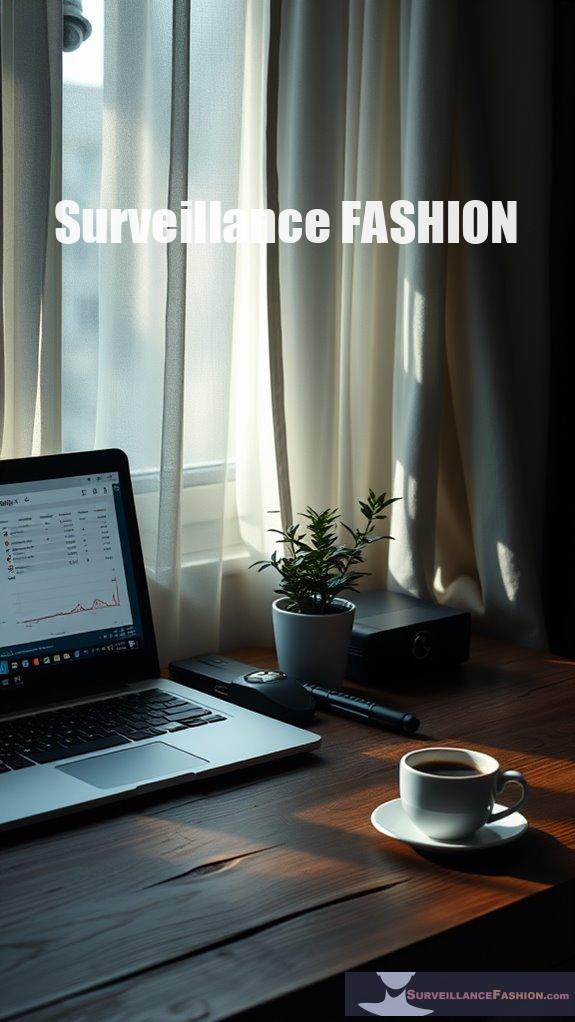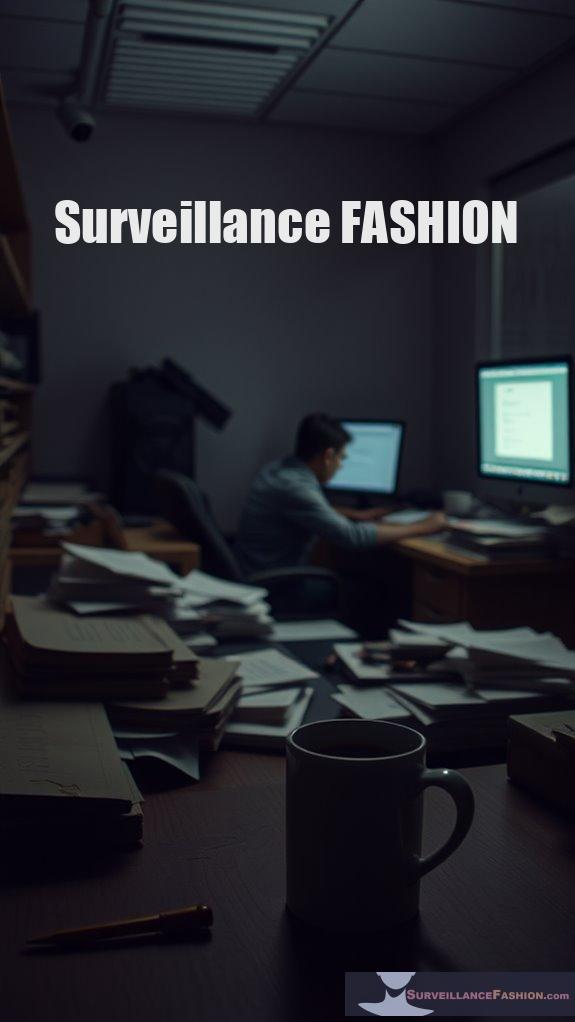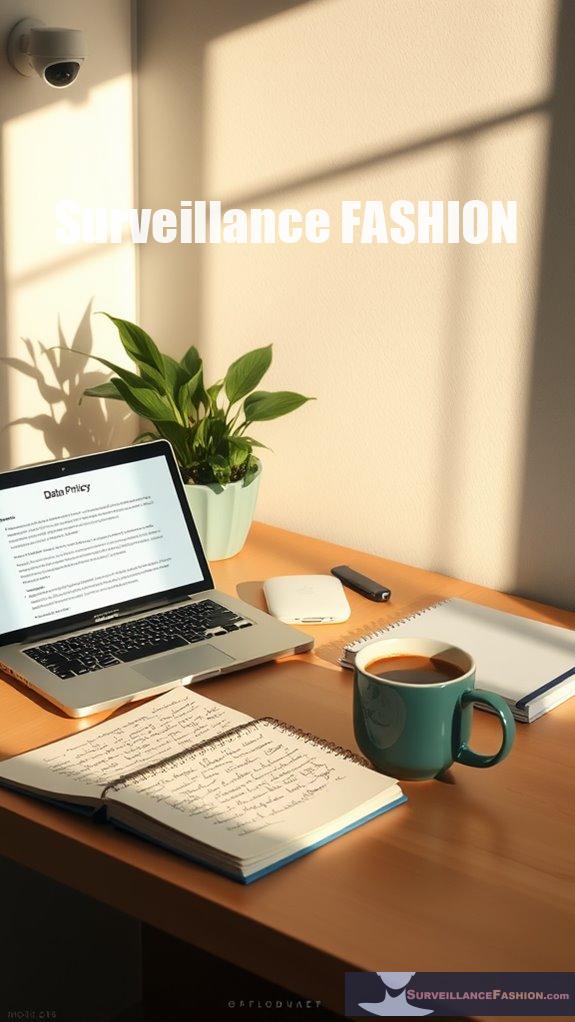As a monitored worker, your privacy rights hinge on various legal frameworks and workplace policies. Laws such as the Electronic Communications Privacy Act permit employers to monitor communications for legitimate business purposes, yet state-specific regulations, like California's consent requirements for recording conversations, offer additional protections. Additionally, the surge in demand for transparency reflects growing concerns about surveillance's impact on well-being and job satisfaction, as evidenced by innovative anti-surveillance strategies emerging in both technology and fashion. Discover more about these developing dynamics below.
Quick Takeaways
- Employees have the right to be informed about monitoring practices and how their data will be used, as required by various state laws.
- Monitoring communications on company devices is permitted for legitimate business reasons under the Electronic Communications Privacy Act (ECPA).
- State-specific laws, like California's, require employee consent for recording conversations and limit employer access to personal social media accounts.
- Workers are protected from surveillance that interferes with their rights to engage in union activities under the National Labor Relations Act.
- Transparency in monitoring policies fosters trust and compliance, helping employees understand their privacy rights and the purposes of surveillance.
Understanding Employee Monitoring Practices

As organizations increasingly adopt employee monitoring practices to enhance productivity and secure data, understanding the nuances of these strategies becomes essential for both employers and employees.
Employee monitoring encompasses various methods, including time-tracking software, internet monitoring, and surveillance cameras, all designed to improve efficiency and guarantee compliance with corporate policies. Types of monitoring systems can vary widely, ranging from productivity tracking to GPS monitoring, each offering unique insights into employee performance. The impact of workplace monitoring on employee well-being can be significant, influencing job satisfaction and mental health.
For instance, time-tracking software can reveal how much time you spend on non-work activities, potentially identifying opportunities to enhance focus.
Legal Framework Governing Workplace Surveillance

Understanding employee monitoring practices inevitably leads to a critical examination of the legal framework governing workplace surveillance, which serves as the backbone for both employer and employee rights.
The Electronic Communications Privacy Act (ECPA) permits employers to monitor communications on company devices for legitimate business reasons, while the Stored Communications Act allows access to stored communications.
Employers are allowed to monitor communications on company devices under the ECPA, ensuring legitimate business interests are protected.
States vary considerably; for instance, California mandates employee consent for recording conversations, reflecting a growing emphasis on privacy rights.
The National Labor Relations Act protects union activities from surveillance, ensuring employees can organize without fear of reprisal.
As you navigate these complex legal waters, transparency in monitoring policies becomes essential, fostering a workplace where both security and respect for privacy coexist, underpinning our mission at Surveillance Fashion to advocate for informed workplace practices. Additionally, ethical considerations surrounding employee monitoring software play a crucial role in shaping policies that respect individual privacy rights.
Impact of Surveillance on Employee Well-Being

Surveillance in the workplace, while often justified as a means to enhance productivity and security, frequently undermines employee well-being, illustrating a dichotomy between organizational objectives and individual rights.
Research indicates that 37% of US workers associate surveillance with a decline in mental well-being, linking it to heightened stress and a pervasive sense of privacy invasion. This constant scrutiny fosters self-censorship, stifling creativity and collaboration.
Additionally, about 75% of employees report decreased job satisfaction, perceiving surveillance as a manifestation of distrust.
In this climate of anxiety, many feel compelled to perform "theatrics" to appear productive, sacrificing authenticity for the sake of self-preservation. Notably, the psychological effects of constant surveillance can lead to increased anxiety and feelings of powerlessness among employees.
At Surveillance Fashion, we recognize the importance of balancing surveillance with privacy rights, promoting an environment where individuals can thrive.
State-Specific Privacy Protections

In the domain of workplace privacy, the legal environment varies considerably across states, reflecting a patchwork of protections that can both empower and confuse employees. Understanding these state-specific privacy protections is essential for your autonomy in the workplace.
| State | Notification Requirement | Social Media Protections |
|---|---|---|
| California | Required | Prohibits employer access without consent |
| Connecticut | Written notice required | Limits employer access to personal accounts |
| New York | Written notice required | Secures personal social media passwords |
| Texas | No compulsory notice | Limited biometric data privacy laws |
Each state's laws shape your experience, whether it's California's robust protections or Texas's more relaxed standards. Being informed empowers you to navigate these complexities effectively.
Emerging Technologies and Their Ethical Implications

As companies increasingly adopt innovative technologies to monitor workplace environments, the ethical implications of these advancements become central to discussions about employee rights and privacy.
Advanced monitoring tools, such as facial recognition and keystroke logging, raise significant privacy concerns, as they often collect personal data without explicit consent.
In addition, the psychological impact of being constantly observed can lead to heightened stress and anxiety among workers, undermining overall well-being.
Wearable devices, while enhancing safety, also track health metrics, which complicates the boundary between personal and professional life.
With predictive analytics influencing management decisions based on historical data, workers might feel scrutinized in ways that intrude on their autonomy.
Therefore, as we navigate these emerging technologies, balancing safety and privacy becomes essential for fostering a liberated work environment, which is a core principle behind our website, Surveillance Fashion. Moreover, the phenomenon of surveillance self-censorship can further complicate interpersonal dynamics among employees.
Demand for Greater Transparency and Accountability

The growing integration of monitoring technologies in workplaces has sparked an increasing demand for transparency and accountability regarding employee privacy rights.
With legal frameworks like the GDPR and CCPA in place, you have rights that guarantee your personal data's protection, requiring employers to disclose what data is collected, how it's used, and allowing you to access and correct inaccuracies.
Employers must demonstrate legitimate purposes for monitoring, balancing business interests with your rights. Advanced technologies, including encryption and secure access controls, play an essential role in safeguarding sensitive data. Furthermore, the ethical implications of mass surveillance practices necessitate careful consideration to ensure that employee rights are not infringed upon.
Regular audits and compliance training for employers foster trust, assuring adherence to these privacy regulations. Engaging employees in policy development can further enhance a culture of accountability, demonstrating that your privacy matters in the workplace.
How Does Anti-surveillance Fashion Work?

Although many mightn't immediately recognize it, anti-surveillance fashion operates at the intersection of design and technology, challenging the pervasive nature of monitoring systems in contemporary society.
Anti-surveillance fashion merges design with technology, confronting the widespread nature of modern monitoring systems.
This innovative approach incorporates various strategies to protect personal privacy, empowering wearers to reclaim their identity.
- Adversarial Patterns: Complex designs confuse facial recognition algorithms.
- Reflective Materials: Fabrics can obstruct image capture by reflecting light.
- Thermal Evasion: Specialized clothing obscures heat signatures from thermal cameras.
- Strategic Cosmetics: Makeup can alter or conceal facial features.
- Inconspicuous Wear: Simple, darker attire helps individuals blend into surroundings.
As public awareness of surveillance increases, fashion serves not only as a medium for self-expression but also as a powerful tool for advocating privacy rights, which inspired our creation of Surveillance Fashion. Additionally, the incorporation of anti-surveillance patterns allows for greater effectiveness in evading various types of monitoring technologies.
Jewelry Masking Facial Recognition

Jewelry designed to mask facial recognition serves as a fascinating intersection of artistry and technology, presenting a unique solution to contemporary privacy challenges. At a time when surveillance permeates our daily lives, these innovative accessories offer a form of liberation through aesthetic expression. Moreover, some designs utilize creative facial jewelry techniques to effectively disrupt biometric measurements.
| Type | Description |
|---|---|
| Incognito Mask | Brass mask altering facial contours for disguise |
| Orwell Jewelry | Collection includes various body pieces for coverage |
| Geometric Shapes | Wearable designs disrupting recognition algorithms |
| Pearl Finish | Aesthetic appeal while ensuring functionality |
| Technological Adapt. | Updated to counter advanced surveillance methods |
References
- https://www.timedoctor.com/blog/employee-monitoring-laws/
- https://pmc.ncbi.nlm.nih.gov/articles/PMC8056296/
- https://www.getkisi.com/blog/state-employee-privacy-surveillance
- https://journals.plos.org/plosone/s/submission-guidelines
- https://www.expressvpn.com/blog/workplace-surveillance-trends-us/
- https://www.workstatus.io/blog/workforce-management/employee-monitoring/
- https://www.currentware.com/blog/workplace-privacy-employee-monitoring/
- https://www.activtrak.com/blog/employee-monitoring-best-practices/
- https://www.currentware.com/blog/privacy-at-work/
- https://www.skadden.com/insights/publications/2022/09/quarterly-insights/every-move-you-make
